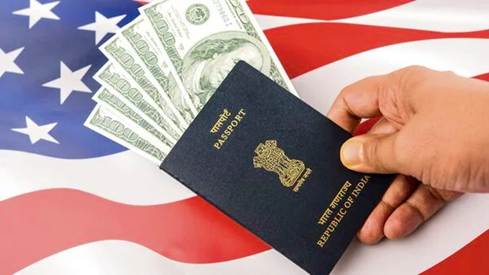Context
- H-1B Visa: U.S. work visa allowing companies to employ foreign professionals in specialized fields (tech, engineering, medicine, etc.).
- Previous Fee: $2,000–$5,000 per application.
- New Fee: Raised sharply to $100,000 for fresh applicants, effective midnight, September 20 (New York time).
- Scope: Initially applied only to applicants “currently outside the U.S.”; later clarified as a one-time fee per petition, not annual.
Relevance:
- GS2 (International Relations / Governance):
- India–U.S. relations, bilateral trade and workforce mobility.
- Diplomatic response, humanitarian concerns for Indian citizens abroad.
- GS3 (Economy / Science & Technology):
- Impact on Indian IT services, skilled workforce mobility, and project continuity.
- Implications for economic competitiveness, talent migration, and global tech industry.

Immediate Implications
- Impact on Indian workers:
- Indians account for 71% of H-1B beneficiaries (FY 2023-24).
- Median Indian H-1B salary: $95,500 (2024), among the lowest across all nationalities.
- 60% earn ≤ $100,000; 12% earn < $75,000, 47% earn $75,000–$100,000.
- The $100,000 fee could exceed or match many workers’ annual salaries, making sponsorship economically unviable.
- Business and IT sector effects:
- Nasscom warns disruption in onshore projects and continuity risks.
- Small and mid-size tech firms may find hiring Indian H-1B workers unfeasible.
- Timeline of implementation (Sept 21) created operational uncertainty.
- Humanitarian and diplomatic concerns:
- Indian government termed the move likely to have “humanitarian consequences.”
- Missions abroad instructed to assist H-1B holders and families.
Policy Rationale (U.S. perspective)
- Trump administration argument:
- H-1B visas are being used to replace American workers with lower-paid foreign labor.
- Share of IT workers on H-1B visas rose from 32% in FY 2003 to over 65% recently.
- Cited economic and national security threat.
- Commerce Secretary’s statement:
- Companies can no longer justify training foreign workers at nominal fees.
- The $100,000 fee per worker is intended to deter “non–economical” hiring.
Data Analysis
- Salary mismatch:
- Median salary of Indian H-1B workers ($95,500) vs. new fee ($100,000) → cost exceeds earnings for majority.
- Non-Indian H-1B median salary: $120,000; Indians disproportionately affected.
- Potential employer behavior:
- Employers may reduce hiring of Indian professionals.
- Could push Indian IT talent toward alternative destinations (Canada, Europe, Singapore).
Reactions
- Indian Government: Studying full implications, assisting visa holders.
- Industry bodies (Nasscom):
- Warned of disruption in project timelines and uncertainty for businesses.
- Highlighted the short notice as particularly problematic.
Clarifications
- One-time fee: White House clarified that the $100,000 fee applies only to new petitions, not annual for current visa holders.
- Flight surge avoided: Initial panic over visa fees triggering mass returns mitigated by this clarification.
Broader Implications
- Economic / Tech Sector:
- Could slow India-U.S. tech workforce integration.
- Small to mid-size IT companies disproportionately affected; large corporations may absorb cost.
- Possible impact on bilateral trade negotiations, as this coincided with key Indo-U.S. trade discussions.
- Human Capital & Migration:
- May push Indian professionals to seek other migration routes (Canada’s tech visas, Europe).
- Could reduce U.S. tech sector competitiveness in the long term if high-skilled talent inflow decreases.
- Political Messaging:
- Domestic U.S.: Framed as protecting American jobs.
- India: Seen as a diplomatic irritant; potential impact on India-U.S. bilateral cooperation.



